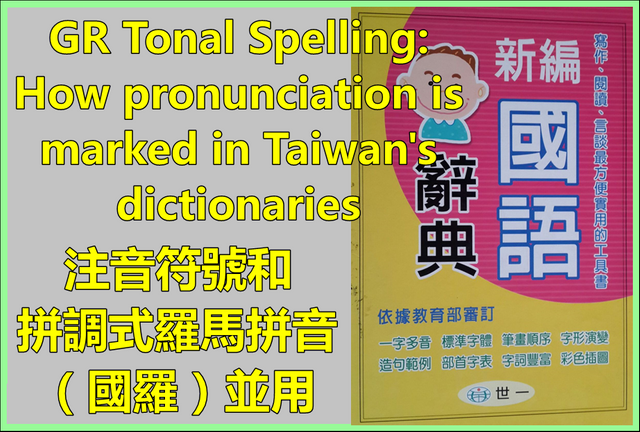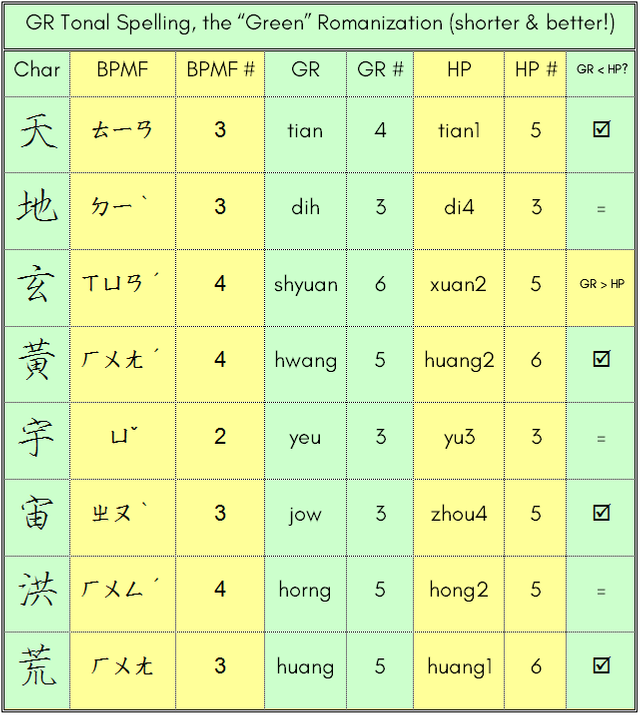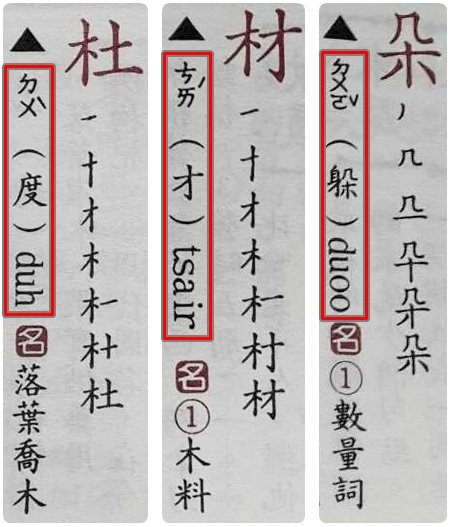GR Tonal Spelling: How Pronunciation Is Marked In Taiwan's Dictionaries 注音符號和拼調式羅馬拼音(國羅)並用

The majority of dictionaries published in Taiwan include both注音符號 zhùyīn fúhào / juhin fwuhaw “National Phonetic Symbols” (known in English as Zhuyin or Bopomofo) and their younger brother, 拼調式羅馬拼音 pīndiàoshì luómǎ pīnyīn / pindiawshyh luomaa pin’in “GR Tonal Spelling”(舊名:國語羅馬字 former name: Gwoyeu Romatzyh/Gwoyeu Luomaatzyh “National Romanization”).
Bopomofo (BPMF) and GR Tonal Spelling (GR) were actually created by some of the same people. BPMF, promulgated in 1918, was created by a committee composed of representatives from all over China. The purpose of BPMF was to help children and adult speakers of various dialects learn to speak what was then a newly-created artificial language called 國語 Guóyǔ/Gwoyeu [literally] “National Language” [usually known as] “Mandarin”.
Ten years later (1928), GR, created by a subgroup within the national committee, was promulgated by the Ministry of Education. As its name suggests, the special feature of GR Tonal Spelling is that it uses minor changes in how a word is spelled to denote tonal differences. GR is actually a “green” spelling system, one that uses as few symbols as possible.
Several years ago, I did a systematic analysis of three different transcriptions (Bopomofo, GR Tonal Spelling and Hanyu Pinyin) of the 1000 syllables in the 千字文 Qiānzìwén / Chiantzyhwen “Thousand Character Classic”. I was somewhat surprised to discover that despite its more frequent use of letter pairs, GR was significantly more compact than Pinyin, by a ratio of 374:412 (explained below).
A glance at the first eight characters of the 千字文 shows that in almost every case, the Pinyin forms are longer than the corresponding GR forms (Pinyin “cheats” by adding the tone marks above vowel letters, but each mark should be counted as a separate grapheme [a grapheme is a basic unit of writing that shows a meaningful contrast to another, such as F versus G]):

In 4 out of 8 cases, GR uses one less grapheme than Pinyin; in 3 cases they are the same length; in only one case is GR longer than Pinyin (shyuan > xuán).
Total number of syllables:
1000 (1st tone, 227; 2nd tone, 273; 3rd tone, 167; 4th tone, 333)
Total number of graphemes:
Bopomofo = 2986; GR Tonal Spelling = 3744; Pinyin = 4124
Average number of graphemes per syllable:
Bopomofo = 2.99 graphemes; GR Tonal Spelling = 3.74 graphemes; Pinyin = 4.12 graphemes.
Now let’s take a look at three characters belonging to the “tree/wood” radical section of the dictionary. Each character is provided with a stroke-by-stroke graphic showing how to write it in the correct sequence.
Next, the pronunciation is shown in three different ways:
(A) spelled in Bopomofo
(B) shown via a homonym (in parentheses)
(C) romanized in GR Tonal Spelling (Gwoyeu). From left to right:
1. 杜 the -h in duh stands for 4th tone (the last half-stroke in -h is a visual reminder that this tone is abruptly falling: du4 in Hanyu Pinyin)
2. 材 the -r in tsair stands for 2nd tone (the rising squiggle in -r is a visual reminder that this tone is rising: cai2 in Hanyu Pinyin)
3. 朵 the double -oo in duoo stands for 3rd tone (the 3rd tone is much longer than the other tones in Mandarin: duo3 in Hanyu Pinyin)

(The character 名 below each pronunciation note means that these three are all nouns)
All Mandarin dictionaries published in Taiwan show pronunciation using Bopomofo. Most of them also include the GR Tonal Spelling (Gwoyeu). A growing minority of dictionaries are showing Hanyu Pinyin instead, a deplorable trend that shows how little attention most ROC citizens pay to their precious linguistic heritage: GR Tonal Spelling is a cultural treasure to be cherished, not left in a corner to gather dust.